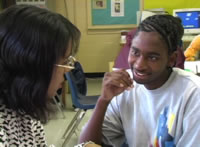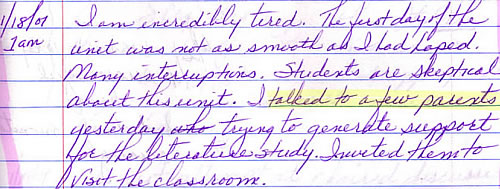Context
Where do I teach?
Teaching Practice
What's my approach?
Student Work
Resources
Standards
Archive
Faculty Lounge
|
Teaching Practice
For more about how I've come to develop my approach, see CEI: Inquiry & Practice.
For more about specific teaching approaches, see Teaching Grammar and Writers Workshop.
| My Classroom Organization |
What if high school English were a place of wondrous discoveries and meaningful accomplishments? While that vision is nothing like what I experienced in high school, it is exactly the image I want shimmering in my students' memories long after they have left my classroom.
I believe in highly individualized instruction in highly socialized settings. Each student developing his or her communication skills while pursuing the questions, topics, or mediums he or she found most compelling (or challenging). This is no small task for a high school teacher considering there have been years when I've taught 150 students per day. Still, every year I strive for the goal of giving each student a very personalized education, while creating a true community of learners who feel a sense of collective responsibility for one another's success.
The first step towards this goal begins with the first two weeks of school. I set the tone the first day a student arrives in my class with a discussion about my classroom standards which must be upheld by everyone who enters our room, including me. Along with the obligatory list of consequences for student violators, are the steps students may take if I fail to come to class prepared or show disrespect towards anyone, up to a conference with the principal. Each student also gives me the name and contact information of a significant adult; someone the student respects who is genuinely concerned about the student's academic success. I contact this person and invite him/or her to act as the student's mentor for the school year.
For the next several days, we will work our way through a series of self-explorations that I use to help me (and the students) learn about their relative strengths and weaknesses as communicators. I have designed and re-designed these activities to cover every aspect of the language arts (reading, writing, listening, speaking, viewing, thinking), as well as probing their control of vocabulary, language conventions, and researching skills.
For the pre-assessments, I select inspirational or motivational materials to plant the seeds of success and positive thinking. However, the most energizing part of the process comes when I meet privately with each student to review his or her preliminary activities, and together, we develop a Personal English Plan. The plan, designed on a grid, is part analysis part wish list. I try to help each student strike a balance between course requirements and personal goals. In our discussions, I usually pose the question: "By the end of another full year in English, what do you want to know or be able to do that you don't know or don't do very well now?" Once we agree upon skills to be learned or perfected, we begin to identify topics or questions of special interest to each student. These Personal English Plans guide our work for the rest of the year with checkpoints and updates at the end of each grading period.
With the exception of large group discussions, which are conducted in large circle in the center of the room, students are free to move about the room to accomplish the learning tasks on which they are focusing each day. Some may be peer editing a classmate's work in a small group, while others may be at the computers. Some are reading, while others may be working with study partners. I am moving around the room, clipboard in hand, as I conference with students, check on progress, encourage fresh thinking, or suggest resources. All this energy culminates at the end of the school year with their presentations of individual Communications Skills Portfolios to the class, mentors, and other invited guests.
While mandated curricula, state standards, and annual testing may be necessary parts of our work in public education, the main event remains students engaged in learning. Empowering language arts instruction is what I call teaching the language arts [listening, speaking, viewing, hearing, reading, and writing] in such a way that students not only become technically proficient or skillful, but also cognizant of the effects of language on others. I want them to experience how language skills can be used to project their own ideas and to critically assess the ideas of others. Such instruction must be dynamic, as opposed to static or scripted, even by the best-intentioned curriculum materials. When I teach in this way, I also learn even more about my students and their lives; I call this process Culturally Engaged Instruction.
I work with each of my students at the beginning and throughout the school year to develop Personal English Plans (we call them PEPs). Based upon approximately two weeks of intensive pre-assessments, I help my high school juniors determine their strengths and weaknesses in relation to the mandated course requirements. The first part of the PEP addresses any mandated areas which need attention. Then, we explore possibilities for individual expression based on interests, concerns, or talents. For example, many of my students like to write poetry outside of school, especially many of the males. I may challenge them to try different styles of poetry or set a publication goal.
Even within the mandated areas, I try to give the students as much choice and variety as possible. For instance, students may usually choose from a selection of readings, self-select writing topics, or try a variety of presentation modes for finished work ranging from drama to web page. One of my course requirements is that students find a way to serve the school or local community through use of their communication skills. This requirement has led to some wonderfully creative and fulfilling moments, such as the time a young lady created a newsletter for patients at the local nursing home. Another student turned his mother's wish for a complete family tree, into a fascinating research project that ended up being a beautifully narrated scrapbook displayed for a while in the local public library. We work hard to develop and maintain a strong ethos of collective responsibility for learning.
Consequently, if one student has successfully "mastered" a particular skill or mandatory objective, the expectation is that she/he will take responsibility for helping others who are still struggling with it. I have found that downplaying competition within the classroom tends to increase students' individual motivation to achieve in order for the entire group to advance together. This cooperative spirit actually flows from the culture of this very rural, very religious African American community. To truly engage students in academic or scholarly work, they must be convinced that work has value for who they are and where they live, not just for some generic future.
|
|
Site last updated
May 19, 2006
|
 Culturally Engaged Instruction:
Culturally Engaged Instruction: 